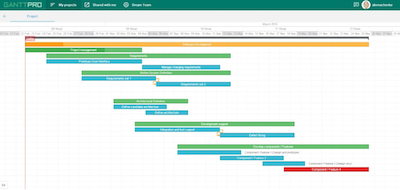Future of AV: Merging of Product Development and Marketing
Engineers invent and innovate. Products are created. Marketing promotes the products. Sales try to, well, sell the products. That’s the way it’s been done in product development for ages including in the audiovisual industry (AVL). And that’s the past. The future is the merging of Product Development and Marketing.
 Whereas the linear path described above is still very much alive and in use today by many in the AVL manufacturing space, it relies on a fundamental ideological tenant that says there’s a delineation and segregation between engineering and everyone else. In the software development world, this linear path was adopted from physical manufacturing until a better way was introduced to develop and deploy software in a fraction of the time and at a fraction of the cost. That new way was dubbed Agile, and the old way was referred to as Waterfall due to the cascading, linear graphs from project planning as illustrated in extensive Gantt charts (see example chart).
Whereas the linear path described above is still very much alive and in use today by many in the AVL manufacturing space, it relies on a fundamental ideological tenant that says there’s a delineation and segregation between engineering and everyone else. In the software development world, this linear path was adopted from physical manufacturing until a better way was introduced to develop and deploy software in a fraction of the time and at a fraction of the cost. That new way was dubbed Agile, and the old way was referred to as Waterfall due to the cascading, linear graphs from project planning as illustrated in extensive Gantt charts (see example chart).
It wasn’t that long ago when software was released every few years (Microsoft Windows is an easy example). Today, new versions are rolled out in months or weeks and Software as a Service revolutionized desktop computing (Office 365 comes to mind). In fact, Agile and DevOps (the merging of Development and Operations to combined product development and quality assurance) are the standard in software development today with success stories in abundance, but perhaps few are as poignant as the stat which shows how Amazon deploys new software to production every 11.6 seconds. Not months or weeks or days or even minutes. Seconds. And they’ve been doing that since 2011.
Unlike writing code, physical products are newly released or updated more slowly, but the principle — the framework of Agile — absolutely can and should apply to AVL manufacturing.
Agile for AVL
Agile is a belief that collaborative teams working in short durations together can deliver more often and change more rapidly, to meet market demands.
Software development used to be fully mapped out, documented and planned for a final finished release before work began. This method, called Waterfall, required all of the pre-planning and documentation for everything the software would need to do in one, very large and complex project plan, complete with Gantt charts to estimate work over months and even years.
Then came Software-as-a-Service (software you use online, in an app, or in a browser, most frequently). It changed the need for more iterative software changes that responded to user demands and perceived needs of users as quickly as possible.
I’ve come to understand how Agile Marketing is ideal for marketing and communication teams that must plan some level of their work (i.e., we all use editorial calendars) but must be able to pivot as new, urgent/unplanned work or changes due to external pressures, such as social media timeliness, a change in publication dates or a shift in the stakeholder’s needs. Combining this workflow in a cross-functional team can result in dividing up the work into inputs, throughputs, outputs and outcomes for both product development and product marketing.
The idea is to merge the process of developing products with feedback and insight from your marketing team’s stats, trends and feedback loops. In this way, a cross-functional team (or teams) are comprised of individuals from engineering, manufacturing, operations and marketing throughout the entire development lifecycle for new products.
Measuring Inputs
Not all projects take the same amount of time, resources and effort. Likewise, not all project requests hold the same value. Marketers intuitively know that a social media post about an upcoming webinar is a simple task and takes far less time, resources, and manpower to execute than creating the content for the webinar.
With the merging of product development and product marketing, prioritizing the work against real-world feedback and stats on the value proposition, features and benefits of existing products can and should influence design decisions.
By measuring inputs, marketers and engineers alike have a powerful set of metrics for both leading indicators and an objective set of data points to evaluate their ability to estimate and deliver the right work.
Measuring Throughput
Agile Marketing makes much of throughput and for good reason: If a team improves in not only doing work but in delivering better work, then KPIs are easier to track against progress and not merely completion. This can easily be seen when the editorial calendar has a number of deadlines in close proximity, as both the marketing team and their executive leadership need to visualize the prioritization of work and make mid-stream adjustments to A) prevent additional interrupt-driven work from impeding progress; B) assess the velocity of planned work against impending deadlines for additional resource allocation or scope reduction (or both); C) that the deadlines for the most valuable content/resources are prioritized ahead of all other work; D) and so that the team can make mid-Sprint decisions to readjust task ownership in order to deliver the best value.
 In my experience and in visiting with hundreds of other marketers, this intermediate metric of throughput isn’t even considered. That’s why I think many (most?) marketers struggle to know if they’re producing the right work or simply more work. The difference is staggeringly important, and would clearly influence the design and manufacturing process to chunk up the creation of a new product into smaller iterations with minimally viable points of release for adding maximum value along the way.
In my experience and in visiting with hundreds of other marketers, this intermediate metric of throughput isn’t even considered. That’s why I think many (most?) marketers struggle to know if they’re producing the right work or simply more work. The difference is staggeringly important, and would clearly influence the design and manufacturing process to chunk up the creation of a new product into smaller iterations with minimally viable points of release for adding maximum value along the way.
Measuring Outputs
In Agile Marketing, the team chooses a relative effort value when prioritizing and planning work using the Scrum or Scrumban practices. This is reflected as a value for low-effort tasks compared to high-effort tasks and is attributed to each Story (task or set of sub-tasks) before the work has begun. The marketing team decides this as a group and then works their plan and measured what they got done versus what they originally estimated what they’d get done. The point is never to ‘get more done’ but to get better at estimating, which in the long run helps them get more of the right things done.
As a product is being developed with insights from marketing who is likely producing content to hint at the upcoming new product in development, the outputs of demonstrable iterations will influence the final requirements of the new product so that only the most valuable features and specs are built into the new product.
Measuring Outcomes
The ultimate marketing conversion rate is tied back to a business outcome and not a marketing deliverable. It’s not enough to publish more content, create better landing pages, target audiences with better segmentation or even get a higher conversion rate on forms. Those are outputs and they are absolutely needed; they’re just not the point of why we do what marketing does in and of themselves.
To measure an outcome means that marketing has aligned their teams and work to meet business objectives. For example, if a business has an objective of creating a customer loyalty program to the frequency and volume of purchases by consumers, then marketing has to define Key Performance Indicators (KPIs) to ensure that the work completed and deliverables produced actually lead to a thriving customer loyalty program. This is an outcome, not an output.
In the case of merging product development and product marketing, the goals of the new product release are baked into the expected sales performance of the new product, which are streamlined and created in concert with engineers, operations and sales. And all of this happens before the product ever ships!
The day of marketers being judged on the delivery of outputs with the vanity metrics of old are long gone. It’s like the old days of Google Ads where ‘impressions’ were a big deal until someone figured out that lots of impressions with zero sales was minimally useful. As marketers, we must be measured with KPIs that matter, and the only ones that matter are those directly related to an organization’s mission. In the case of product development for AVL manufacturers, the orchestration of Agile and DevOps should also now include the data and insights from marketing in order to bring the highest value with the least complexity to market.





